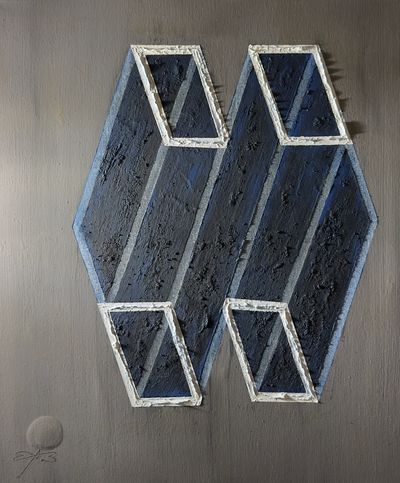Opposite Parallels
Tibor Babos
Geminimal Collection
Paradox Constructivism / Constructive Unrealism
2024
60 x 50 cm (23.6 in x 19.6 in)
Oil on 3D+ Canvas
Budapest
In Private Collection
Opposite Parallels (2024) by Tibor Babos is a visual proposition that reads less like a painting and more like a dimensional theorem. Anchored in the conceptual foundations of Paradox Constructivism, Babos’s signature sub-discipline within Constructive Unrealism, this work offers a crystalline meditation on simultaneity, contradiction, and metaphysical displacement. The title alone — Opposite Parallels — initiates a paradox, collapsing the boundary between logic and poetry. It hints at a system where dualities coexist without resolution, where form doesn’t reveal truth but deepens its obscurity.
At the center of the composition, six rhomboid prisms — angular, blue-black, and seamed in textured white — stand aligned yet misaligned, parallel yet adversarial. They appear to move in two directions at once, held in magnetic repulsion. The structure suggests mirrored sequences: timelines diverging while visually harmonized, entities locked in symmetrical opposition. The very geometry of the work subverts Euclidean comfort, introducing a logic of estrangement. These are not forms that meet. They orbit each other in suspended detachment, echoing the fundamental tragedy of parallelism — that which runs beside can never converge.
Babos renders this contradiction not only through composition but through material resistance. The prism interiors are worked with heavy, almost geological oil layers, coarse and blackened in texture. These fields feel carved, not painted — like tectonic surfaces marked by unseen pressures. Against this ruggedness, the outlines are edged in chalky, light-toned relief, textured but clean, luminous like boundaries between perception and event. These outlines do not contain the form; they fracture it. They function as apertures through which another dimensional logic briefly flickers.
The grey background is smooth, nearly atmospheric, a void without anchoring reference. This is not a background in the traditional sense — it is conceptual space. It holds the forms like a question holds a thought: suspended, unsettled, unresolved. Its neutrality is illusory. Subtle gradations and tonal shifts within the grey suggest both depth and emptiness, like an environment caught between states of matter, or the visual equivalent of uncollapsed probability.
Color plays an epistemological role. The ultramarine-black interior of each prism evokes not only cosmic depth, but psychic depth — dense, unknowable, and vast. This is a color of concealment and reverence, invoking something sacred within the structural. The faint blues that emerge at certain angles feel like memory leaking through form. And the luminous white edgework becomes an active paradox: sharp yet soft, declarative yet unstable. It hints at contact points — brief alignments between opposites — before vanishing back into separation.
The painting’s 3D+ canvas furthers the illusion of dimensional fluctuation. Depending on the viewer’s position and the light’s angle, the work shifts — its surfaces expand and contract, its shadows realign. This is not a static object but an optical field. It resists final interpretation because it is built from the premise that understanding, like reality, is always partial. Even the scarring on the surface, the incidental scratches and interruptions, feel like intrusions from parallel timelines — aesthetic bleed-throughs from other versions of the same painting.
Opposite Parallels arrives in a moment where certainty is no longer available — culturally, politically, cosmologically. It speaks to a world fractured by simultaneity: multiple truths, conflicting timelines, recursive futures. In such a landscape, Babos does not seek to impose order. He reclaims geometry as a vessel for doubt. The painting becomes a visual lexicon for the ungraspable — not to answer the metaphysical question, but to formulate it in a new language of contradiction and tension.
This is a work that contemplates the physics of perception. It renders space not as a setting, but as a metaphysical challenge. It uses texture as an argument. It enacts philosophy through structure. Babos has produced not just a painting, but a proposition — one that reverberates far beyond its frame. Opposite Parallels doesn’t illustrate an idea. It is the idea, made tactile, made visible, and — crucially — made uncertain.

CONSTRUCTIVE UNREALISM
Budapest / New York / Miami
Copyright © 2025 CONSTRUCTIVE UNREALISM
All Rights Reserved.
This website uses cookies.
We use cookies to analyze website traffic and optimize your website experience. By accepting our use of cookies, your data will be aggregated with all other user data.
